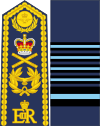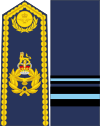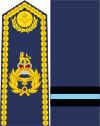Women's Royal Air Force: Difference between revisions
m ordinals not normally used in dates (WP:DATESNO); image->file |
|||
| (12 intermediate revisions by 8 users not shown) | |||
| Line 1: | Line 1: | ||
| ⚫ | |||
{{Infobox military unit |
{{Infobox military unit |
||
|unit_name= Women's Royal Air Force |
|unit_name= Women's Royal Air Force |
||
|image=Buckingham Palace (13996052528).jpg |
|||
|image= |
|||
|image_size=280px |
|||
|caption= |
|||
|caption=25 July 1919: King's Open Court, Buckingham Palace tribute to WW I Workers. – shown: members of the Women's Royal Air Force. |
|||
|dates= 1918–1920<br/>1949–1994 |
|dates= 1918–1920<br/>1949–1994 |
||
|country= |
|country= |
||
| Line 11: | Line 10: | ||
|type= |
|type= |
||
|role=Support services |
|role=Support services |
||
|size=Peak of ~25,000 (1918–1920) |
|||
|size= |
|||
|garrison= [[RAF Hawkinge]] |
|garrison= [[RAF Hawkinge]] |
||
| commander2 = [[Princess Alice, Duchess of Gloucester]] |
| commander2 = [[Princess Alice, Duchess of Gloucester]] |
||
| Line 27: | Line 26: | ||
|anniversaries= |
|anniversaries= |
||
}} |
}} |
||
| ⚫ | |||
The '''Women's Royal Air Force''' ('''WRAF''') was the women's branch of the [[Royal Air Force]]. It existed in two separate incarnations: the [[Women's Royal Air Force (World War I)|Women's Royal Air Force from 1918 to 1920]] and the Women's Royal Air Force from 1949 to 1994. |
The '''Women's Royal Air Force''' ('''WRAF''') was the women's branch of the [[Royal Air Force]]. It existed in two separate incarnations: the [[Women's Royal Air Force (World War I)|Women's Royal Air Force from 1918 to 1920]] and the Women's Royal Air Force from 1949 to 1994. |
||
| ⚫ | |||
On 1 February 1949, the name of the First World War organisation was revived when the [[Women's Auxiliary Air Force]], which had been founded in 1939, was re-established on a regular footing as the Women's Royal Air Force. The WRAF and the RAF grew closer over the following decades, with increasing numbers of trades opened to women, and the two services formally merged in 1994, marking the full assimilation of women into the British forces and the end of the Women's Royal Air Force. |
On 1 February 1949, the name of the First World War organisation was revived when the [[Women's Auxiliary Air Force]], which had been founded in 1939, was re-established on a regular footing as the Women's Royal Air Force. The WRAF and the RAF grew closer over the following decades, with increasing numbers of trades opened to women, and the two services formally merged in 1994, marking the full assimilation of women into the British forces and the end of the Women's Royal Air Force. |
||
The Central Band of the WRAF, one of only two all-female bands in the British Armed Forces, was disbanded in 1972. Some of its musicians transferred to the Band of the [[Women's Royal Army Corps]]. |
The Central Band of the WRAF, one of only two all-female bands in the British Armed Forces, was disbanded in 1972. Some of its musicians transferred to the Band of the [[Women's Royal Army Corps]]. |
||
{{TOC limit|3}} |
|||
| ⚫ | |||
[[File:WRAF working on a De Havilland 9A. Q27562.jpg|thumb|left|210px|A fitter of the Women's Royal Air Force working on the [[Liberty L-12|Liberty]] engine of a [[De Havilland]] [[Aircraft Manufacturing Company|Airco]] [[Airco DH.9A|DH.9A]].]] |
|||
==Strength== |
==Strength== |
||
[[File:Sanders and Hanbury IWM GOV 2669.jpg|thumb|The Best Cadet receives her certificate from Air Marshal [[Arthur Sanders (RAF officer)|Sir Arthur Sanders]] and Air Commandant [[Felicity Peake|Dame Felicity Hanbury]], the first Director of the Women's Royal Air Force, at [[RAF Hawkinge]].]] |
|||
The target strength had been a force of around 90,000, figures are unreliable until 1 August 1918, when the strength was 15,433, approximately 5,000 recruits and 10,000 transferred from the predecessor organisations. The first incarnation never exceeded 25,000.<ref>{{Cite book|title=Women in Air Force Blue|page=21}}</ref> |
The target strength had been a force of around 90,000, figures are unreliable until 1 August 1918, when the strength was 15,433, approximately 5,000 recruits and 10,000 transferred from the predecessor organisations. The first incarnation never exceeded 25,000.<ref>{{Cite book|title=Women in Air Force Blue|page=21}}</ref> |
||
==Depots== |
==Depots== |
||
Depots were opened in 1918 at Handsworth College, in Glasgow, at [[RAF Flowerdown]], [[RAF Spitalgate]], near Grantham, and at York. In the 1950s the WRAF Depot and WRAF Officer Cadet Training Unit were opened at [[RAF Hawkinge]] in Kent. |
Depots were opened in 1918 at Handsworth College, in Glasgow, at [[RAF Flowerdown]], [[RAF Spitalgate]], near Grantham, and at York. In the 1950s the WRAF Depot and WRAF Officer Cadet Training Unit were opened at [[RAF Hawkinge]] in Kent. |
||
==Ranks== |
==Ranks== |
||
| Line 47: | Line 51: | ||
{{Ranks and Insignia of NATO Armed Forces/OF/Blank}} |
{{Ranks and Insignia of NATO Armed Forces/OF/Blank}} |
||
{{Ranks and Insignia of NATO Air Forces/OF/WRAF_1949-1968}} |
{{Ranks and Insignia of NATO Air Forces/OF/WRAF_1949-1968}} |
||
| ⚫ | |||
|- style="text-align:center;" |
|||
| ⚫ | |||
| colspan=2| [[File:United Kingdom-Air force-OF-10-collected.svg|50px]] |
|||
| colspan=2| [[File:United Kingdom-Air force-OF-9-collected.svg|50px]] |
|||
| colspan=2| [[File:United Kingdom-Air force-OF-8-collected.svg|50px]] |
|||
| colspan=2| [[File:United Kingdom-Air force-OF-7-collected.svg|50px]] |
|||
| colspan=2| [[File:United Kingdom-Air force-OF-6-collected.svg|50px]] |
|||
| colspan=2| [[File:British RAF OF-5.svg|30px]] |
|||
| colspan=2| [[File:British RAF OF-4.svg|30px]] |
|||
| colspan=2| [[File:British RAF OF-3.svg|30px]] |
|||
| colspan=2| [[File:British RAF OF-2.svg|30px]] |
|||
| colspan=3| [[File:British RAF OF-1b.svg|30px]] |
|||
| colspan=3| [[File:British RAF OF-1a.svg|30px]] |
|||
| colspan=6| [[File:UK-RAF-OFD.svg|30px]] |
|||
| colspan=6 rowspan=2| '''''No equivalent''''' |
|||
|- style="text-align:center;" |
|||
| colspan=2| [[Marshal of the Royal Air Force|Marshal of the RAF]] |
|||
| colspan=2| [[Air chief marshal]] |
|||
| colspan=2| [[Air marshal]] |
|||
| colspan=2| [[Air vice-marshal]] |
|||
| colspan=2| [[Air commodore]] |
|||
| colspan=2| [[Group captain]] |
|||
| colspan=2| [[Wing Commander (rank)|Wing commander]] |
|||
| colspan=2| [[Squadron leader]] |
|||
| colspan=2| [[Flight lieutenant]] |
|||
| colspan=3| [[Flying officer]] |
|||
| colspan=3| [[Pilot officer]]<br/>/[[acting pilot officer]] |
|||
| colspan=6| [[Officer cadet]] |
|||
|} |
|} |
||
[[File:First Chief Controller, Queen Mary's Army Auxiliary Corps (QMAAC) in France, Dame Helen Gwynne-Vaughan, GBE. Art.IWMART3048.jpg|thumb|170px|Dame Helen Gwynne-Vaughan, {{Post-nominals|country=GBR|size=100%|sep=,|GBE}}, WRAF Commandant 1918–1920.]] |
|||
These ranks were introduced in 1949. The First World War service used different ranks. |
These ranks were introduced in 1949. The First World War service used different ranks. |
||
| Line 81: | Line 60: | ||
*[[Gertrude Crawford]], 1918 |
*[[Gertrude Crawford]], 1918 |
||
*[[Violet Douglas-Pennant]], May–September 1918 |
*[[Violet Douglas-Pennant]], May–September 1918 |
||
*[[Helen Gwynne-Vaughan]], September |
*[[Helen Gwynne-Vaughan]], September 1918 – 1920 |
||
==List of Directors WRAF== |
==List of Directors WRAF== |
||
*[[Felicity Peake|Air Commandant Dame Felicity Hanbury]], 1949–1950 |
*[[Felicity Peake|Air Commandant Dame Felicity Hanbury]], 1949–1950 |
||
*[[Nancy Salmon|Air Commandant Dame Nancy Salmon]], 1950–1956 |
*[[Nancy Salmon|Air Commandant Dame Nancy Salmon]], 1950–1956 |
||
*[[Henrietta Barnett (WRAF officer)|Air Commandant Dame Henrietta |
*[[Henrietta Barnett (WRAF officer)|Air Commandant Dame Henrietta Barnett]], 1956–1960 |
||
*[[Anne Stephens (WRAF officer)|Air Commandant Dame Anne Stephens]], |
*[[Anne Stephens (WRAF officer)|Air Commandant Dame Anne Stephens]], 1960–1963 |
||
*[[Jean Conan Doyle|Air Commandant Dame Jean Conan Doyle]], |
*[[Jean Conan Doyle|Air Commandant Dame Jean Conan Doyle]], 1963–1966 |
||
*[[Felicity Hill|Air Commodore Dame Felicity Hill]], 1966–1969 |
*[[Felicity Hill|Air Commodore Dame Felicity Hill]], 1966–1969 |
||
*[[Philippa Marshall|Air Commodore Philippa Marshall]], 1969–1973 |
*[[Philippa Marshall|Air Commodore Philippa Marshall]], 1969–1973 |
||
| Line 111: | Line 91: | ||
== Further reading == |
== Further reading == |
||
{{ |
{{Commons category|Women's Royal Air Force}} |
||
*BE Escott, Women in Air Force Blue: the story of women in the Royal Air Force from 1918 to the present day - 1989 - Stephens |
*BE Escott, Women in Air Force Blue: the story of women in the Royal Air Force from 1918 to the present day - 1989 - Stephens |
||
*KB Beauman, Partners in Blue: The Story of Women's Service with the Royal Air Force - 1971 - Hutchinson Radius |
*KB Beauman, Partners in Blue: The Story of Women's Service with the Royal Air Force - 1971 - Hutchinson Radius |
||
| Line 118: | Line 98: | ||
[[Category:Royal Air Force]] |
[[Category:Royal Air Force]] |
||
| ⚫ | |||
| ⚫ | |||
[[Category:Sex segregation]] |
|||
[[Category:1949 establishments in the United Kingdom]] |
[[Category:1949 establishments in the United Kingdom]] |
||
[[Category:1994 disestablishments in the United Kingdom]] |
[[Category:1994 disestablishments in the United Kingdom]] |
||
| ⚫ | |||
| ⚫ | |||
[[Category:Women's organisations based in the United Kingdom]] |
[[Category:Women's organisations based in the United Kingdom]] |
||
Latest revision as of 03:19, 21 November 2023
| Women's Royal Air Force | |
|---|---|
 25 July 1919: King's Open Court, Buckingham Palace tribute to WW I Workers. – shown: members of the Women's Royal Air Force. | |
| Active | 1918–1920 1949–1994 |
| Allegiance | |
| Branch | Royal Air Force |
| Role | Support services |
| Size | Peak of ~25,000 (1918–1920) |
| Garrison/HQ | RAF Hawkinge |
| Commanders | |
| Last Director WRAF | Air Commodore Ruth Montague |
| Air Chief Commandant | Princess Alice, Duchess of Gloucester |
The Women's Royal Air Force (WRAF) was the women's branch of the Royal Air Force. It existed in two separate incarnations: the Women's Royal Air Force from 1918 to 1920 and the Women's Royal Air Force from 1949 to 1994.
On 1 February 1949, the name of the First World War organisation was revived when the Women's Auxiliary Air Force, which had been founded in 1939, was re-established on a regular footing as the Women's Royal Air Force. The WRAF and the RAF grew closer over the following decades, with increasing numbers of trades opened to women, and the two services formally merged in 1994, marking the full assimilation of women into the British forces and the end of the Women's Royal Air Force.
The Central Band of the WRAF, one of only two all-female bands in the British Armed Forces, was disbanded in 1972. Some of its musicians transferred to the Band of the Women's Royal Army Corps.

Strength
[edit]
The target strength had been a force of around 90,000, figures are unreliable until 1 August 1918, when the strength was 15,433, approximately 5,000 recruits and 10,000 transferred from the predecessor organisations. The first incarnation never exceeded 25,000.[1]
Depots
[edit]Depots were opened in 1918 at Handsworth College, in Glasgow, at RAF Flowerdown, RAF Spitalgate, near Grantham, and at York. In the 1950s the WRAF Depot and WRAF Officer Cadet Training Unit were opened at RAF Hawkinge in Kent.
Ranks
[edit]The WRAF inherited its rank structure from its predecessor, the WAAF. As with WAAF practice (from 1940), other ranks held standard RAF ranks, but officers used a separate ranking system until 1968, when they too adopted RAF officer ranks.
| NATO code | OF-10 | OF-9 | OF-8 | OF-7 | OF-6 | OF-5 | OF-4 | OF-3 | OF-2 | OF-1 | ||||||||||||||||||||||||||
|---|---|---|---|---|---|---|---|---|---|---|---|---|---|---|---|---|---|---|---|---|---|---|---|---|---|---|---|---|---|---|---|---|---|---|---|---|
(1949–1968) |

|

|

|

|

|

|

|

|
||||||||||||||||||||||||||||
| Air Chief Commandant[note 1] | Air Commandant | Group Officer | Wing Officer | Squadron Officer | Flight Officer | Section Officer | Assistant Section Officer
| |||||||||||||||||||||||||||||

|

|

|

|

|

|

|

|

|

|

| ||||||||||||||||||||||||||
| Marshal of the RAF | Air chief marshal | Air marshal | Air vice-marshal | Air commodore | Group captain | Wing commander | Squadron leader | Flight lieutenant | Flying officer | Pilot officer /acting pilot officer | ||||||||||||||||||||||||||

These ranks were introduced in 1949. The First World War service used different ranks.
List of Commandants WRAF
[edit]- Gertrude Crawford, 1918
- Violet Douglas-Pennant, May–September 1918
- Helen Gwynne-Vaughan, September 1918 – 1920
List of Directors WRAF
[edit]- Air Commandant Dame Felicity Hanbury, 1949–1950
- Air Commandant Dame Nancy Salmon, 1950–1956
- Air Commandant Dame Henrietta Barnett, 1956–1960
- Air Commandant Dame Anne Stephens, 1960–1963
- Air Commandant Dame Jean Conan Doyle, 1963–1966
- Air Commodore Dame Felicity Hill, 1966–1969
- Air Commodore Philippa Marshall, 1969–1973
- Air Commodore Molly Allott, 1973–1976
- Air Commodore Joy Tamblin, 1976–1980
- Air Commodore Helen Renton, 1980–1986
- Air Commodore Shirley Jones, 1986–1989
- Air Commodore Ruth Montague, 1989–1994
See also
[edit]- Air Transport Auxiliary
- Patricia Howard
- Women Airforce Service Pilots, US equivalent
- Women's Royal Army Corps
- Women's Royal Naval Service
Notes
[edit]- ^ An honorary rank held only by Princess Alice, Duchess of Gloucester, who held it as a rank (until 1968) and later an appointment throughout the WRAF's existence. On 1 April 1994 her title changed to Air Chief Commandant for Women, RAF, by which time she held the rank of Air Chief Marshal.
References
[edit]- ^ Women in Air Force Blue. p. 21.
- ^ "RAF Ranks". raf.mod.uk/. Royal Air Force. Retrieved 21 September 2021.
Further reading
[edit]- BE Escott, Women in Air Force Blue: the story of women in the Royal Air Force from 1918 to the present day - 1989 - Stephens
- KB Beauman, Partners in Blue: The Story of Women's Service with the Royal Air Force - 1971 - Hutchinson Radius
